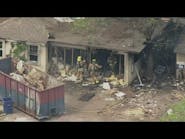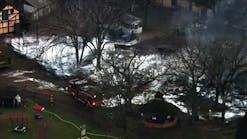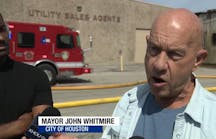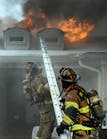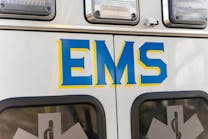Units had positioned their apparatus in front of the fire building. The first-arriving engine officer had ordered a defensive attack and companies were stretching large-diameter hoseline for master-stream operations.
Photo by Joe Hoffman A problem facing the initial incident commander at a fire scene is how much water will be needed for effective fire control. This information will impact on the incident in terms of determining needed resources and the implementation of tactical operations.
The chief assumed command and requested second and third alarms. The next order was to immediately move the apparatus from in front of the fire building to a flanking position. This would remove them from the collapse zone and should the fire reach the level anticipated by the chief, it would not be necessary to relocate the apparatus at a later time under potentially dangerous conditions.
Before the apparatus could be moved, however, the intensity of the fire increased tremendously. Flames were being driven by the high winds from the fire building, causing paint to bubble on the apparatus in front of the fire building. Plastic reflectors were melting and window glass on a tower ladder was cracking due to the intense heat. Firefighters were now scrambling. A pumper had to be driven away while still connected to a hydrant, tearing the couplings from the hoseline suction. The disruption of moving the apparatus now meant a delay in placing master streams into operation, compounding an already serious situation.
The intensity of the fire now ignited vehicles parked in the driveways of the dwellings across the street from the fire building. The radiant heat attacked the vinyl siding, melting it. Wood moldings on doors and windows of the dwellings now started to ignite. Residents in night clothing were being evacuated under the protection of hoselines.
Hoselines were placed to knock down the fire spreading to the dwellings. The firefighters were now faced with the threat of flying fire brands being carried downwind and starting incipient fires a distance away. A brand patrol was dispatched and extinguished numerous fires.
As the situation stabilized, firefighters were reporting to first-aid stations for treatment of burns sustained in moving the apparatus. Though minor, they could have been avoided by recognition of the potential seriousness of the situation by the first-arriving units and proper initial placement of apparatus.
Needed Fire Flow
A problem facing the initial incident commander at a fire scene is how much water will be needed for effective fire control. This information will impact on the incident in terms of determining needed resources and the implementation of tactical operations.
Determining the amount of water needed to extinguish a fire in a specific building is best accomplished during the pre-planning stage. This can be attained through a deliberate calculation of the occupancy, considering conditions when establishing the needed fire flow. When pre-planned information is available to the initial incident commander upon arrival at an incident, strategic and tactical decisions can be made more readily and accurately.
To determine needed fire flow during pre-planning requires the application of a "fire flow formula" to conditions observed during an inspection of the premises. On many occasions, fire incidents are encountered where pre-planned fire flow information is not available. Under these circumstances, experienced fire officers are able to determine the needed fire flow based on their experience and knowledge of similar situations they have encountered in the past.
There are occasions when a newly appointed or relatively inexperienced officer lacking the expertise of a seasoned officer must quickly judge the amount of water needed to effectively control a fire. The National Fire Academy (NFA) in Emmitsburg, MD, has developed a formula that allows for quick calculations. The formula was derived through a study of fire flows which were successful in controlling a large number of working fires, along with interviews of numerous experienced fire officers from throughout the country regarding the fire flows they have found to be effective in various fire situations. The NFA "quick-calculation" formula can be used as a tactical tool to provide a starting point for deciding the amount of water required at an incident scene. This will permit decisions to be made on the apparatus needed to deliver the water and the numbers of firefighters that will be needed to apply it.
The information developed indicated that the relationship between the area involved in fire and the approximate amount of water required to effectively extinguish the fire can be established by dividing the square footage of the area of fire involvement by a factor of three. This formula is expressed as:
Fire flow = length X width ÷ 3
This formula is most easily applied if the estimated square footage of the entire structure is used to determine an approximate fire flow for the total structure and is then reduced accordingly for various percentages of fire involvement.
The example shown below would illustrate how the formula can be applied to a single-family dwelling 60 feet long by 20 feet wide and one story high:
60 X 20 ÷ 3 X 1 (floor) = 400 gpm
100% involvement = 400 gpm
50% involvement = 200 gpm
25% involvement = 100 gpm
The quick-calculation formula indicates that if the dwelling were fully involved, it would require 400 gpm to effectively control the fire. If only half of the building were burning, 200 gpm would suffice, and 100 gpm should be sufficient if one-fourth of the building were involved.
Multi-Story Structures
In multi-story buildings, if more than one floor in the building is involved in fire, the fire flow should be based on the area represented by the number of floors actually burning. For example, the fire flow for a two-story building of similar dimensions as the previous example would be:
60 X 20 ÷ 3 X 2 (floors) = 800 gpm if fully involved
If other floors in a building are not yet involved but are threatened by possible extension of fire, they should be considered as interior exposures and 25 percent of the required fire flow of the fire floor should be added for exposure protection for each exposed floor above the fire floor to a maximum of five interior exposures. (A fire on the first floor would threaten the second floor and 25 percent should be added. A second-floor fire would probably not threaten the first floor, so no interior exposure would need to be calculated).
Exterior Exposures
Likewise, if exterior structures are being exposed to fire from the original fire building, 25 percent of the actual required fire flow for the building on fire should be added to provide protection for each exposure.
The following example shows how to apply calculations for exposures to our previous one-story dwelling with two separate exterior exposed structures:
60 X 20 ÷ 3 X 1 = 400 gpm
2 exposures: 400 gpm X (25% X 2) = 200 gpm
Total fire flow required = 600 gpm (for 100% involvement of the original fire area).
If the exposure becomes involved in fire (either additional floors of a multi-story building or adjacent structures), the exposure(s) should then be treated as a separate fire area and calculated separately, then added to the required fire flow for the original fire area.
In using the quick-calculation method to determine required fire flows, it is important to remember that the answers provided by this formula are approximations of the water needed to control the fire. The formula is geared to an offensive attack and its accuracy diminishes with defensive operations. Don't forget that you are estimating both the area of the building and the amount of fire involvement within the building.
Since firefighting is an inexact science to begin with, the use of the quick-calculation formula cannot be expected to determine the exact gpm that will be specifically required for full fire control. It has been found that as the amount of involvement reaches a stage where a defensive attack is necessary, the needed fire flow will be found to be slightly greater than required.
Available water flow must be known. The type and location of the water supplies should be specified. Provide exact locations if using hydrants or drafting sites. If a tanker/tender operation is to be used, determine how many will be needed.
Determining Type Of Attack
Once the required fire flow has been determined, the capability of available resources will determine the strategy and tactics needed to control the incident. If the fire flow capability of available resources exceeds the required fire flow, an aggressive interior attack on the fire can usually be made. However, before this decision is implemented, the incident commander should consider:
- Do existing conditions allow sufficient safety for the firefighters on an interior attack?
- Is the fire area accessible?
- How many hoselines and firefighters are needed?
- Where is the best location to attack the fire from?
- What support activities are needed? (ventilation, forcible entry, etc.)
If the fire flow requirements exceed the fire flow capability of available resources, a defensive mode of operation is usually required. In these situations, larger hose streams, more apparatus, more equipment and more personnel may have to be requested. The incident commander must recognize that situations will be encountered where nothing can be done with the available resources to save the involved building. In these circumstances, exposure protection becomes the primary objective.
Selection Of Hoseline Recognizing that a 1 1/2-inch or 1 3/4-inch hoseline flows 100 to 125 gpm and a 21/2-inch hoseline flows approximately 250 gpm, we can estimate the number of hoselines and resources needed to control the fire.
While the formula will provide the incident commander with a starting point to determine how much water may be needed for an effective fire attack in normal situations, common sense and good judgment are required to evaluate the effect of the water on the fire as it is being applied. There may be unforeseen factors impacting on the situation, such as barriers that prevent the water from reaching the seat of the fire, or building contents that cause unexpected fire behavior.
If control is not achieved within a reasonable period of time, the amount of water may have to be increased. If immediate knockdown of the fire takes place, the amount of water being applied can be reduced to minimize water damage to the structure and contents.
Sprinkler Systems
If protective systems are contained within the structure, they should be noted in the pre-plan. Information on these systems is imperative for sound decisions to be made. (One major fire that destroyed a sprinklered building was due to a maintenance man shutting down the electricity, which shut down the water supply, and a malfunction prevented the backup water system from activating.)
A sprinkler system's supply must be maintained. If pumpers are hooked up to hydrants supplying the sprinkler system from a small water main, they may steal the water from the sprinkler system, a counterproductive move.
Summary
The calculations resulting from the needed fire flow formula is just another tool. An officer with little experience can find the tool quite helpful when faced with a fire situation which he or she has not confronted before. How the tool is used can mean the difference between success and failure.
Though no system will supplant experience, the utilization of a variety of methods will assist responding firefighters in implementation and deployment of resources at an emergency incident.
James P. Smith, a Firehouse® contributing editor, is a deputy chief of the Philadelphia, PA, Fire Department and an adjunct instructor at the National Fire Academy in Emmitsburg, MD.
James P. Smith
JAMES P. SMITH, who is a Firehouse contributing editor, is a retired deputy chief of the Philadelphia Fire Department. He is an adjunct instructor at the National Fire Academy and the author of the fourth edition of the book "Strategic and Tactical Considerations on the Fireground," which was published by Brady/Pearson.

